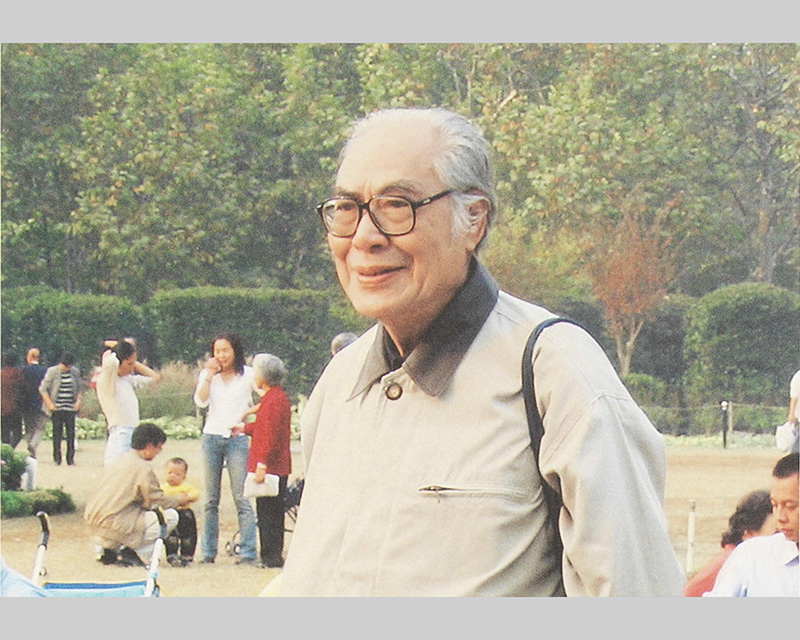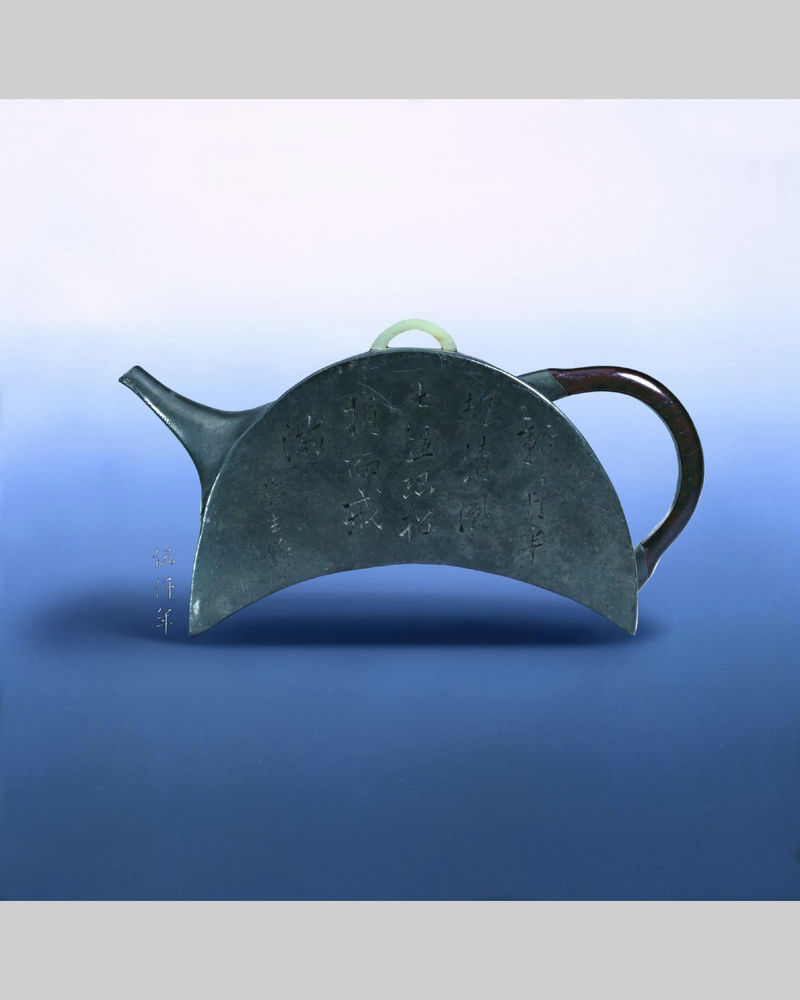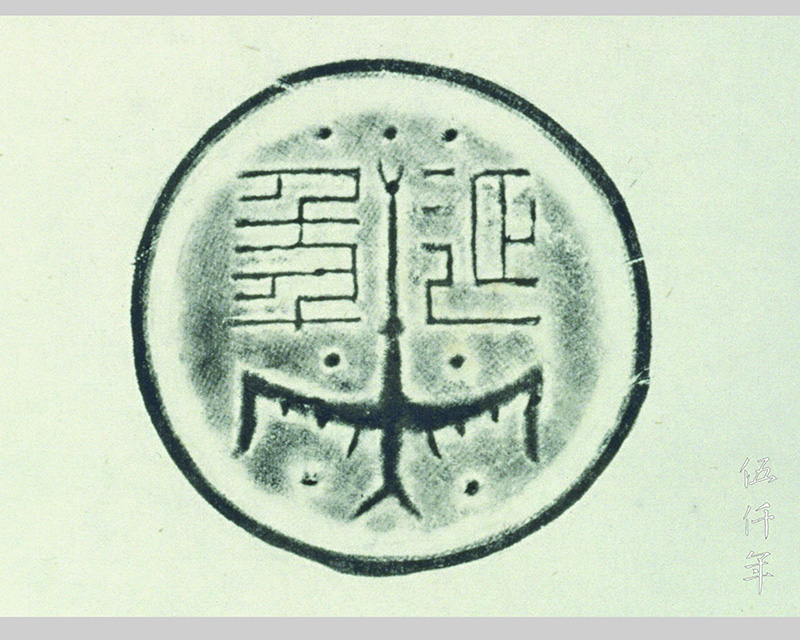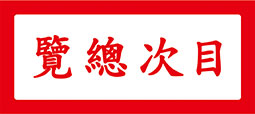
Detail of the waning moon pewter teapot by Ch’en Man-Sheng, Yang P’eng-nien and Wang Hung
Remembering twenty years ago, my departed friend Mr. Chang Shou-p’ing (張壽平先生) introduced me to Mr. Kuo Jo-yü (郭若愚先生) in Shanghai. Mr. Chang mentioned at the time that the seals carved by the masters of the Hsi-ling School in Mr. Kuo’s collection, were exquisite and ingenious without equal, and I was most anxious to see them as early as feasible. In the following years, I regularly visited Shanghai, every time I would visit Mr. Kuo in his Chin-mei-hua Shih (Studio of Golden Prunus) on Huaihai Road, and had numerous opportunities to thoroughly examine his collection of a few hundred seals by the distinguished seal engravers of the Ming and Ch’ing dynasties. The seals were exceedingly rich in styles and periods, they were also some of the finest representations of these artists’ works. The seal collection of Mr. Kuo could rival those great collections of the early Republican era, such as the four seal collections of Ting Fu-chih (丁輔之 1879-1949), Kao Shih-fu (高時敷 1886-1976), Ko Ch’ang-ying (葛昌楹 1892-1963) and Yü Jen-ts’ui (俞人萃 1897-1942). I deeply regret that the world did not know of Mr. Kuo, more so when the world could not see his treasures. In the 89th year of the Republic (2000), I edited and published his writings before and after the Cultural Revolution on seal engraving, and compiled them into a single volume: The Art of Seal Engraving in China, Biographies of Selected Artists. The profound learning of Mr. Kuo, can be testified by his various publications: Yin-ch’i shih-to (A Selection of Oracle Bones 殷契拾掇), Yin-ch’i wen-tzu chui-ho (A Selection of Oracle Bone Characters 殷契文字綴合), Hung-lou-meng feng-wu k’ao (A Study of the Customs and Artifacts in the Story of the Stone 紅樓夢風物考), T’ai-p’ing T’ien-kuo ko-ming t’u-lu (A Pictorial Record of the Revolution Artifacts of the Taiping Rebellion 太平天國革命圖錄) and others. As our friendship grew, I then realized that the art collection of Mr. Kuo, not only contained the category of seal engraving, but also ink rubbings of stone inscriptions, calligraphy, paintings, bronze works, inkstones, bamboo engravings, drinking vessels and coins. These were all his passions, important pieces were abundant, dazzling and moving. Unfortunately, most of the ink rubbings of stone inscriptions were appropriated by the public museums after they were forcefully confiscated during the Cultural Revolution, and Mr. Kuo regularly evoked this as his lifelong resentment. Mr. Kuo was one of the great connoisseurs of our time, to examine his art collection, there were acute discernment and steadfast research, the dubious discarded and the authentic retained, it was a true benchmark for future generations.

Portrait of Mr. Kuo Jo-yü, former collector of the waning moon pewter teapot
A number of times in the Studio of Golden Prunus, I saw the waning moon pewter teapot designed by Chen Man-sheng (陳曼生). The teapot was placed in a light brown wooden box, stored in the lower quarter of a tall wall cabinet. Chen Man-Sheng designed mostly clay teapots, pewter teapots were rare. Only two are known, this is one, the other is seen on an ink rubbing, also in the collection of Mr. Kuo. It is not known whether the original teapot still exists.
Chen Man-sheng, name Hung-shou, tzu Tzu-kung, hao Man-sheng, Man-shou, Chung-yü Tao-jen, native of Ch’ien-t’ang, Chekiang province. He was born in the 33rd year of the Ch’ien-lung reign (1768), and died in the 2nd year of the Tao-kuang reign (1822). He attained the pa-kung degree in the 6th year of the Chia-ch’ing reign (1801), and was appointed to the consecutive positions of county magistrate of Li-yang and sub-prefect of coastal defense of Nan-ho. He excelled in poetry, calligraphy, painting and seal engraving, and was particularly celebrated in seal engraving, popularly known as one of the eight masters of Hsi-ling School. He was fond of the art of the drinking vessels, and created eighteen teapot forms. His work is titled Chung-yü Hsien-kuan shih-ch’ao (The Poetry of Chung-yü Hsien-kuan 種榆僊館詩鈔).
Chen Man-sheng was celebrated for his eighteen teapot forms, in reality his designs exceeded this number. The eighteen teapot forms are: 1. Stone Pot 2. Straight Well 3. Waning Moon 4. Horizontal Cloud 5. Monk’s Robe 6. Double Pleasure 7. Spring Delight 8. Spring Maiden 9. Rainbow Sip 10. Melon 11. Gourd 12. Celestial Cock 13. Sky and Earth 14. Globular 15. Archaic Pot 16. Bronze Mirror and Tile 17. Go Bowl 18. Cuboid. Chen Man-Sheng pursued carefree imaginations with poetic artifacts, plants and astronomical imageries, elicited their essential delights, then instilled them into teapots, extricating the design of teapots from the customary duplications and imitations of past generations.

Front of the waning moon pewter teapot by Ch’en Man-Sheng, Yang P’eng-nien and Wang Hung. Former collection of Mr. Kuo Jo-yü

Ink rubbing of front of the waning moon pewter teapot by Ch’en Man-Sheng, Yang P’eng-nien and Wang Hung
Waning moon, is also imperfect moon, or half moon. Li Kang (李綱 1083-1140), an eminent official of the Southern Sung dynasty (1127-1279) wrote a tz’u poem with lines: “The waning moon resembles a hook, light cloud at half veil, so lustrous is the sweep of sprinkling stars.” Ko Li-fang (葛立方 ?-1165), a literatus of the Southern Sung dynasty, wrote another tz’u poem with lines: “This moment of slight chill, the first autumn breeze, the inclined moon resembles a hook.” Poetry is visually expressive, the shape of waning moon, is conclusively a hook. For the Waning Moon design in Chen Man-sheng’s range of eighteen forms, if it were moulded in clay, how could it seriously produce the sharp pointed shape of a hook? It would only end in likeness. Pewter is basically a soft and malleable metal, using it to make a teapot in the shape of waning moon, it becomes a concave silver hook, the bright luster reflects like mirror, it naturally belongs to a different world comparing to a teapot moulded in clay, it is truly superior! Our mundane world has unseeing eyes, how many can appreciate this fact?
The height of Chen Man-sheng’s waning moon pewter teapot is 9.6 cm, the handle made of mahogany, the finial of the cover made of white jade. One side was engraved with words in cursive script: “A new semicircle moon, light breeze and seven cups of contemplations, beware of fullness that provokes decline.” Signed: “Engraved by Man-sheng.” The calligraphy and engraving were executed by Chen Man-sheng. The other side was engraved with a branch of prunus, signed: “Work by Hsiao-yü” The incised lines on both sides were infilled with lacquer.

Back of the waning moon pewter teapot by Ch’en Man-Sheng, Yang P’eng-nien and Wang Hung. Former collection of Mr. Kuo Jo-yü

Ink rubbing of back of the waning moon pewter teapot by Ch’en Man-Sheng, Yang P’eng-nien and Wang Hung
Hsiao-yü was the hao of Wang Hung (汪鴻 1768-1822), tzu Yen-nien, native of Hsiu-ning, Anhwei province. He was an advisor to Chen Man-sheng during his official postings. He excelled in the painting of flowers, birds and landscape, his works were more refined than those of his contemporaries. His friendships included Ch’ien Tu (錢杜 1764-1844), Kai Ch’i (改琦 1774-1829), Chang Liu (張鏐 ?-1821), Kuo Lin (郭麐 1767-1831), Ts’ao Yen-ch’un (曹言純 1767-1837) and others. Wang Hung was also an accomplished seal engraver, he could skillfully work on many materials, such as gold, bronze, porcelain, stone, tile, bamboo and wood. He was able to restore the zither, a musical instrument, he also composed musical score, played the flute, and was proficient at engraving clay teapot. I once saw a floral painting in the format of a fan by Wang Hung, it was stylistically identical to the floral painting of Chen Man-sheng. The inscription was: “Green dress and lovely face, we met in an evening, September camellia, blossoming along my journey. Dedicated to Mr. Po-sheng. Wang Hung.” I also came across The Concise Seal Dictionary published by Shanghai Paintings and Calligraphy Publishing House, and saw a seal engraved by Wang Hung: P’in-weng liu-shih i-hou han-mo (The works of Pin-weng after sixty years old, 頻翁六十以後翰墨). This should be a seal carved for Kuo Lin. It is almost untenable to differentiate this from those by Chen Man-sheng.
At the base of Chen Man-sheng’s waning moon pewter teapot, is the pattern of a diagonal trellis in relief. It is subtle and archaic, an additional embellishment and an unexpected diversion. One might speculate when Chen Man-sheng designed this part, he was alluding to a poetic vista as could be found in the poem by Wu Ch’ien (吳潛 1195-1262) of the Southern Sung dynasty: “Strings of frost, in the early morning garden, moon resembling a hook, by the balustrade at dusk.”
Chen Man-sheng enjoyed designing teapots, but the craftsmanship of making teapots was not within the realm of his ability. His clay teapots were all crafted by Yang P’eng-nien (楊彭年), who was an eminent craftsman during the Ch’ien-lung and Chia-ch’ing reigns. Yang was accomplished in making both clay and pewter teapots, members of his family were also proficient. A globular pewter teapot designed by Chu Chien (朱堅) and crafted by Yang P’eng-nien is in the collection of the Studio of Prunus Ode, hence one can deduce that the waning moon pewter teapot by Chen Man-sheng, was also hand crafted by Yang P’eng-nien.

Ink rubbing of the Fei-hung yen-nien pewter teapot by Chen Man-sheng, executed by Mr. Kuo Jo-yü, his teacher Juan Hsing-shan painted a prunus and added a colophon
The ink rubbing of another pewter teapot by Chen Man-sheng was in the collection of Mr. Kuo. At the exterior base of the teapot is the design of an ancient tile in relief, with the pictogram fei-hung (swan in flight 飛鴻) and the characters yen-nien (to extend life 延年). At the interior base of the teapot is a seven character seal: Man-sheng zuò hu yung pao yung (Teapot made by Man-sheng to be cherished and used for posterity, 曼生作壺永寶用). On one side is engraved some words in clerical script: “To fill up with sacred spring water, drinking it will render long life.” Signed in cursive script: “Engraved by Man-sheng”. This teapot was in the collection of Juan Hsing-shan (阮性山 1891-1974), original name Chi-tseng, hao Hsing-shan, Mu-wu, T’o-hu, T’o-weng, native of Hang-chou, Chekiang province. He excelled in coloured floral painting, in particular prunus and bamboo. There is a long inscription on the ink rubbing:
“For teapots by Chen Man-sheng, it is particularly rare to see those made of pewter. I acquired this eight years ago. My young friend Jo-yü visited my studio, saw the pewter teapot and fell in love, he made this copy of ink rubbing with his hands. There is not one iota of difference with the original shape, it is exquisite beyond comparison. I painted a branch of flower, merely to enhance idle pleasure. I am notably abashed that my painting is inadequate. Mu-shih Chü-shih recorded this at San-hung Ts’un-she in southern Shanghai, on the fifth day after Autumn Moon Festival in the year wu-tzu (戊子), and about to return to Hang-chou. Seal impressions: Juan, Hsing, Shan.”
The year wu-tzu (戊子) was the 37th year of the Republic, 1948. After Mr. Kuo made the ink rubbing, in addition, he asked his teacher Juan Hsing-shan to paint a prunus.
Examining the photographs of the belongings from my departed friend, the pleasures we shared in publication, exhibition, art appreciation, and conversation in former times were now like the happenings of yesterday. Yet Mr. Kuo Jo-yü had already passed away for ten years.

Ink rubbing of the underside of the Fei-hung yen-nien pewter teapot by Chen Man-sheng, showing a pictogram of fei-hung (swan in flight) and the characters yen-nien (to extend life)




